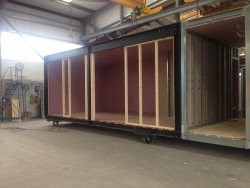Modular appears to have a slight branding problem – a critical shame, as it could have a transformative effect on UK housing. Richard Hyams, Director at astudio, is part of a new wave of architects and building designers engaging with transformational offsite manufacture.
Earlier this year, a survey found that 51% of people would not choose to live a modular home, and 41% believe that modular homes are less durable than conventionally built houses. But when shown images of different builds, 90% of people were unable to identify which were modular.
The government currently spends around £2 million every day on providing temporary accommodation for the country’s 77,000 homeless households. And home ownership has fallen to just 27%, with house prices now, on average, seven times average incomes.
Last month, the Royal Institution of Chartered Surveyors (RICS) called on the government and construction industry to embrace modular in order to aid modern-day housing delivery. But recommendations and industry debate have yet to turn into broader acceptance of modular homes, and currently the UK remains heavily reliant on labour-intensive methods of construction. Housing construction in the UK continues to stagnate, with only 217,000 homes being built per year compared with the 300,000 that are needed – a shortfall of almost one-third.
Modular has the potential to reinvigorate supply in an affordable, efficient way. There are myriad ways to use modular, from big volume builds down to smaller projects, and modular micro-homes can cost as little as £75,000 to build (20% less than a standard build, according to statistics from modular housing developer Comfortable Living). These reduced costs can be passed on to buyers, making houses cheaper by around £25,318 – crucial at a time when 100,000 affordable homes need to be built a year.
They can also be constructed in as little as three days, and require a workforce with months, rather than years, of training to carry out that construction. Given the construction industry is being threatened with a mass exodus of workers following Brexit, utilising modular construction methods might not just be an appealing way of building homes, but a necessity.
If well-designed and considered from the outset, such homes can also be disassembled with relative ease, meaning they can be moved to different locations as demographics shift and housing requirements change. This ease and flexibility of construction could prove extremely useful in major cities such as London, which is expected to see a population explosion in the next 25 years and is predicted to need an additional 844,000 new homes by 2041.
The potential of modular housing has already been picked up by some councils across England such as Wolverhampton and Birmingham, London’s City Hall has said it is willing to give more funding to modular development, Homes England provided additional funding for the sector and Sadiq Khan recently promised a 16-borough collaboration £16 million to provide modular houses for the homeless.
Abroad, high-end companies like Huf-Haus in Germany have revolutionised the modular housing market by providing homes that are attractive, affordable and sustainable. In Sweden, 84% of Swedish detached homes use prefabricated elements – compared with only 5% in the UK.
But wider attitudes in the UK continue to hold modular back from realising its potential. There remain concerns that its novelty and variety can make warranties, insurance, development finance and mortgages harder to secure – but this is not the case. Offsite construction has the potential to be a valuable, sustainable way of delivering the homes we need. Thoughtfully designed manufacturing techniques can help everyone from first-time buyers to construction companies while improving the quality of the homes we own. With Brexit looming large and the need for affordable houses only becoming increasingly urgent, it is critical that we embrace modular’s ability to lift the UK out of its housing crisis – and fast.
For more information visit: www.astudio.co.uk/modular
Original Link - Offsite Magazine









